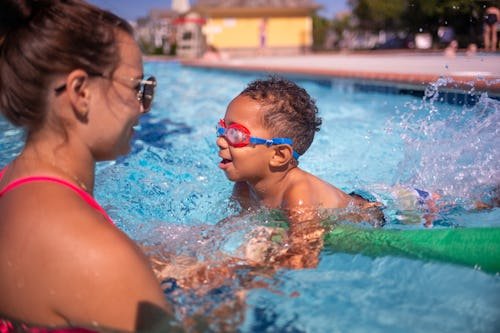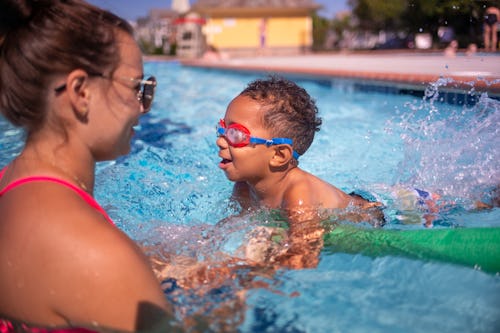

With the end of another school year coming to a close, parents and kids alike will be looking for some fun summer activities to do together. From barbecues and picnics to “day camping” and miniature golf, the list of possible outdoor adventures is endless. Yet one of the most tried-and-true pastimes associated with this time of year has to be swimming. It’s fun, refreshing, and a great way for kids to burn off that never-ending supply of energy they seem to have stored up. But as great as it may be, many parents are unsure when exactly they should introduce this particular activity to their child. Is there a certain age at which kids should learn how to swim, and how should the entire process be approached?
To help us tread through the murky waters of this vital topic, Scary Mommy spoke with Thomas Hollingsworth, a former competitive swimmer and head swimming coach in Queensland, Australia, who shared some enlightening insights on the subject matter — as well as what to look for in a swim class and the numerous benefits that can come from familiarizing children with swim instruction at a young age.
What is the best age to start learning to swim?
The short answer is between ages 1 and 4, but as with anything else, there’s some nuance we should discuss. The American Academy of Pediatrics (AAP) recommends beginning swim lessons as early as age 1 to protect against the risk of drowning. However, that doesn’t mean you can’t familiarize your baby with the process before then with trips to the local pool or even signing up for a parent-child water play class just for fun. In fact, Hollingsworth believes that the sooner you can get your little one in the water, the better.
“Ideally, children should start learning to swim as early as possible, as this helps them to build confidence in the water and develop key motor skills faster,” Hollingsworth says. “Early exposure also significantly reduces the likelihood of fear later on.”
“We have research that shows it drastically reduces the risk of drowning if they receive lessons about the time they start to walk. If they have basic water survival skills, the learning to flip and float, then you’ve got time to find them and get them out [of the water],” said Dr. Benjamin Hoffman, M.D., president of the AAP, in an interview with Romper.
That being said, if you’d feel more comfortable waiting until your child is a little bit older, that’s completely up to you. It’s worth noting, though, that the AAP strongly believes that all children should be ready and capable of tackling swim lessons by the age of 4. By this point in their development, kids are equipped to learn the basic skills needed for water safety. This includes treading water, floating, and finding their way out of the water.
What should you look for when choosing a swim class?
With so many options out there these days, it can feel overwhelming for parents to decide what they should be looking for in their child’s swim class. And while it’s important to include your own personal taste in the equation, there are a few crucial factors to look out for. “It’s key to look for passionate, certified instructors and a swim school with a well-structured development program that ensures the correct skill acquisition at the right level and age,” Hollingsworth explains. “Another aspect is to consider the class size and the quality of the facilities. Smaller class sizes mean more individual attention, and well-maintained facilities ensure a safe and clean environment.”
There’s also the matter of group lessons versus private lessons, both of which have advantages. “Group classes foster social interaction, allow children to learn from their peers, and make learning fun, which keeps them engaged,” Hollingsworth states. “Private lessons offer personalized attention and can accelerate skill development.”
The National Drowning Prevention Alliance has a helpful free checklist on their website to help parents decide on the right swim program for their child. The NDPA’s executive director, Adam Katchmarchi, PhD, told Romper that parents should ask where the swim instructor got certified, what their teaching style is like, and what you can expect your child to learn within the timeframe of the program.
What are the benefits of learning how to swim?
Obviously, the most significant benefit of all boils down to safety. The Consumer Product Safety Commission (CPSC) found that 69% of children under the age of 5 were not supposed to be in the water at the time of drowning, which is what makes learning to swim so crucial. Constant supervision is paramount, of course, but the more knowledge your child has on the matter, the better equipped they are for any unforeseen incidents that come their way involving the water.
Yet safety isn’t the only reason to dip your toes (literally and figuratively) into these lessons. “Swimming offers a multitude of benefits beyond safety,” Hollingsworth assures. “It teaches discipline, provides structure, and enhances motor skills and coordination. Learning to swim can also boost a child’s confidence and self-esteem as they achieve new skills and milestones.”
Hollingsworth adds that it’s also a great way to incorporate physical activity and exercise into your child’s day, which can lead them to “maintain a healthy lifestyle into adulthood, reducing the risk of chronic diseases and improving mental health throughout their lives.”
Ultimately, it will be up to you to make an informed decision about your child’s aquatic endeavors. But with so many pros in its favor, it seems safe to say that swim lessons are certainly well worth the effort.


